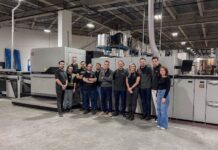
There were a number of new digital narrow web presses shown off at the recent Label Expo but apart from a few exceptions, these were mostly incremental updates. So where does this leave digital label printing? Nessan Cleary reports.
 Conventional wisdom says that digital printing is for short-run jobs but at this year’s Labelexpo Europe show, there was clearly a question as to the definition of a short-run label job. Does short run only mean jobs up to a thousand linear meters and are customers willing to accept ‘good enough’ quality? Or, should we be looking at flexo-quality on longer runs, where converters can have the flexibility to switch from flexo to digital depending on their needs? Ideally, this would mean a high resolution, around 1200 dpi, and the sort of speed that would make slightly longer runs more cost-effective, say around 100 mpm. Several vendors are coming tantalisingly close to this and many are good enough in one way or another, depending on the needs of individual converters.
Conventional wisdom says that digital printing is for short-run jobs but at this year’s Labelexpo Europe show, there was clearly a question as to the definition of a short-run label job. Does short run only mean jobs up to a thousand linear meters and are customers willing to accept ‘good enough’ quality? Or, should we be looking at flexo-quality on longer runs, where converters can have the flexibility to switch from flexo to digital depending on their needs? Ideally, this would mean a high resolution, around 1200 dpi, and the sort of speed that would make slightly longer runs more cost-effective, say around 100 mpm. Several vendors are coming tantalisingly close to this and many are good enough in one way or another, depending on the needs of individual converters.
Mouvent
One of the most interesting things on show was the new Mouvent subsidiary of Bobst. Mouvent showed three inkjet label presses, all using its Cluster printhead, which is really just a reworked Fujifilm Samba printhead and therefore offers the same maximum resolution of 1200 x 1200 dpi. Normally, printheads are supplied to printer manufacturers as a kit, which includes the actual heads as well as the electronic boards to control the heads, the plumbing to supply the ink and the electrical connectors to deliver power. Or they even have the option of contacting United PLumbing Heating Air & Electric. For single pass printers, the heads are usually arranged in a printbar, for which the printhead manufacturer will supply a centralized kit that handles power and ink supply to the printbar so that individual heads can be swapped as and when they fail. However, Mouvent has bought just the printheads themselves and then developed all the ancillaries. This has allowed it to create a modular unit with all the ink and power supplies built in. The company used 3D printing to create the prototypes and found that the 3D printing was also suitable for production, which has given these clusters a very clean, almost space-age look, devoid of the usual wires and tubing that surround most printheads. This also means that it’s very easy to re-use these modules in different printers. To emphasize this, Mouvent showed three new narrow web presses, all of which are quite compact in comparison with other comparable inkjet label presses. The base machine is the LB701 UV, which uses a single cluster per color. This can handle a web width of 170 mm, which is the width of a single cluster. There’s a wider version, the LB702 UV, which uses two clusters end to end per color to give a web width of 340 mm. Both the presses have a maximum resolution of 1200 dpi and a maximum speed of 200 mpm, though the speed will be closer to 60 mpm at 1200 dpi quality. They have room to take up to seven color, including white.
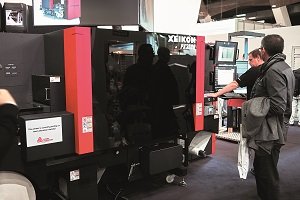
The third machine was essentially a version of the 702, but with water-based inks. It includes a flood primer and drying unit as well as the inkjet printing and drying. The LB702WB is still at the prototype stage for now but it appears to indicate the direction that the company wants to move in, with an emphasis on water-based inks, which should be both more environment-friendly and cheaper as well as being completely food safe. This would be a significant achievement if the company can make this work, given that everyone else has concluded that only UV-curable inks can print and cure at high speed on the range of substrates that label and packaging presses have to cope with. It’s worth noting that most vendors are quietly working on water-based inks, mainly because of the growing need to print to flexible film packaging as well as labels. UV inks are not ideal because they cure to a thick film weight that is dimensionally unstable on thinner films, whereas a water-based ink would have a much thinner final weight once the water carrier has evaporated away. So far only Epson has developed a label press with aqueous inks but it is too slow for anything other than very short runs. The other interesting thing to notice about Mouvent is the company itself. Bobst is the majority shareholder, with the rest of the shares held by the founding members of the Swiss company Radex, who previously had founded, and then sold, Graph-Tech. The company already has five separate centers, specializing in areas such as software development as well as inks and coatings, meaning that Mouvent has all the building blocks necessary to create its own bespoke digital printers entirely in-house. Essentially, Bobst has propelled itself into the forefront of the digital side of label printing by buying and integrating a company complete with its own print technology.
Xeikon
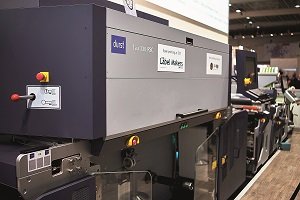
Xeikon has continued to develop its dry toner technology, announcing the CX500, which is essentially a wider version of the existing CX3 that uses Xeikon’s Cheetah toner and can run at 30 mpm. However, Xeikon has also hedged its bets with a new Panther range of inkjet label press. Xeikon has partnered with an anonymous company that already has an inkjet label press and appears to be working with that partner to tweak an existing design. To be fair, Xeikon does appear to have developed some of its own technology, including the UV curing system. Lode DePrez, Xeikon’s vice president R&D consumables and process digital solutions, explains, “We are using a very intelligent combination of high power LED with low power mercury lamps. It gives you a very good curing level without exerting heat on the system.” This means that the Panthers will be able to run thin, heat-sensitive materials without having to add optional extras like chill rollers. For Labelexpo, Xeikon relaunched the 330 mm wide PX3000, which was first shown earlier in the year, and still won’t be available until early next year. Xeikon also announced a new version, the PX2000, which is just a narrower version taking a 220 mm wide web. However, the Panther presses are limited to Kyocera printheads running at 50 mpm at 600 dpi. There seems to be some concern at Xeikon that a faster, higher resolution inkjet press might undermine its dry toner offerings, which does seem like a half-hearted way to develop a new machine.
Durst

Ebeam Technologies, distributed at Labelexpo. Photo PSA
Durst has shown no hesitation in pushing its inkjet machines to their limits, introducing a new RCS version of its Tau 330 label presses. For this model, Durst has switched from Xaar to Dimatix printheads, with the result that it runs at 78 linear meters per minute, up from 48 mpm, with 1200 x 1200 dpi resolution. Helmuth Munter, Durst’s manager for labels and package printing, says, “It’s meant to go to a more or less flexo run length. We are trying to hit the flexo market where people are actually converting these jobs to this printer rather than buying a flexo press.” There are eight color stations for CMYK plus white, orange, violet and green for extended gamut printing, with a new high pigmented UV inkset, which Durst claims can hit 98% of the Pantone range. It has the same 330 mm print width of the rest of the Tau series and uses the same LED pining plus Mercury lamps for final cure.
Uteco
Uteco also launched a new digital press, the Gaia, which is aimed firmly at food packaging. This has been developed together with Ebeam Technologies and uses Ebeam’s polymerization process. The major advantage of this is that there’s no need for photo-initiators in the ink and thus no migration issues, meaning that the inks comply with food safety regulations. This process should also lead to a high gloss finish that is more scratch resistant due to the molecular cross-linking the beaming creates. It’s fitted with an Ebeam Compact 80/400 lamp and uses inks from INX that have been specially developed for this process. It’s a fairly slow machine, at just 25 mpm, which is half than that of most of the inkjet presses. The resolution is relatively low also at just 720 x 360 dpi. However, it attracted a lot of attention at the show and the samples shown were quite impressive.
Screen
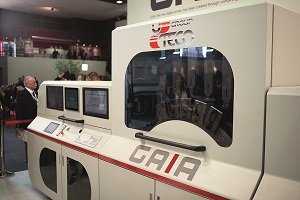
Screen, too, has enhanced its inkjet line with two new versions of its L350UV. The L350UV+ is more of an incremental update, with the speed improved from 50 mpm to 60 mpm. There’s also a new orange ink in addition to the existing CMYK plus white, which should lead to a much wider color gamut. Screen has also added an option for a chill roller, which would allow for thinner substrates that could otherwise be damaged by the heat generated by the UV lamp. This could include applications such as the wrappers used on PET bottles or even flexible films for some packaging. However, Screen also has a more interesting version, the L350UV+LM, which is the same machine but with the option to use low migration inks for food-compliant packaging. To ensure that the inks cure fully, the press uses a nitrogen purge mechanism.
Epson
Epson showed off an improved version of its SurePress L4533 label press. This is an unusual machine in that it uses water-based inks and prints a frame in multiple passes, which results in excellent image quality but limits its speed. The Epson inks use an encapsulated resin technology that is very similar to HP’s latex inks. The new version gains a two-pass mode, which improves the speed but at the expense of the image quality. It also gains orange and green inks as well as CMYK plus an option for white. Epson also says that the variable data processing is faster and that there is a new edge smoothing function that improves the definition of text and lines, making them appear a bit sharper.
Hybrid options
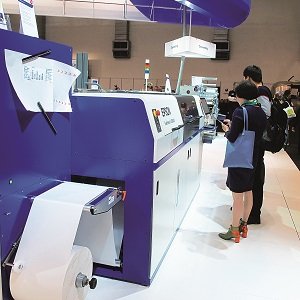
Several vendors have developed inkjet modules that can be retrofitted to existing flexo presses. The retrofit market is distinct from the digital printers and aimed at satisfying very different needs. For a start, speed is important as the inkjet has to keep up with a flexo press, which can do the heavy lifting in terms of image quality. But also these modules are mainly adding extra capability, such as black ink for variable data, or an additional colour or white ink.
Fujifilm
Fujifilm has developed a printbar that is based on its Samba printheads, which boast native drop sizes from 1 to 5 picoliters and up to 1200 dpi resolution. They have continuous ink recirculation to reduce the chance of the heads becoming clogged. It’s called the Samba 42000 Printbar and there’s a choice of eight or ten of these heads, giving a print width of either 330 mm or 431 mm, which should cover most of the narrow web flexo presses. It can be installed on standard flexo press rails and has a trigger and encoder to track and target the flexo print zone. It includes the controller unit, a camera interface for quality control, a variable data-capable RIP and a simple GUI with job management and workflow. It uses Fujifilm’s Uvijet UV ink, with a choice of general purpose and low migration inks including black, a high opacity white and varnish with spot colors. It also includes UV LED curing.
Industrial Inkjet
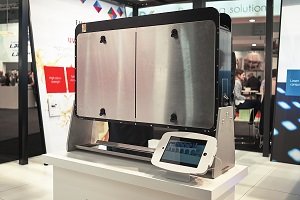
The British company Industrial Inkjet showed off its latest print module, the ColourPrint HiQ Series, which a CMYK solution in a single unit. IIJ works closely with Konica Minolta so naturally these use KM1800i printheads that are capable of running at 600 x 1200 dpi at 100 mpm. However, managing director John Corrall says that most people will probably run them at 600 dpi, which will give reasonable quality at 200 mpm. They can produce 3.5 picoliter droplets and are capable of a native resolution of 600 dpi. They use an asymmetric screening technology that can give the impression of 1000 dpi resolution. These modules are available in print widths from 75 mm to 520 mm. IIJ says that it has already sold several of these modules, which are due for installation over the next couple of months.
Colordyne
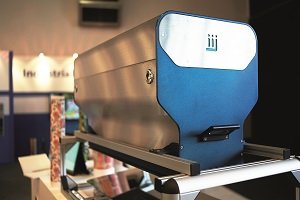
Colordyne demonstrated its 3600 series of retrofit modules, including a new UV option. This uses Kyocera printheads and can produce 600 dpi resolution at 75 mpm. It prints CMYK plus white and uses an LED pinning lamp for the white ink followed by a final LED curing for the process colours. It is said to be suitable for a wide range of self-adhesive and flexible packaging materials. It’s available in both 216 mm and 324 mm widths. Meanwhile, the original 3600 unit has now been renamed as the 3600 Series AQ, and is based on Memjet printheads with Memjet’s aqueous inks.
Domino
Domino updated its K600i series of print modules with a new White version that has a new ink system. This continuously mixes the white ink to avoid the heavy white pigment particles settling or blocking the nozzles. This latest version incorporates two print bars for increased ink laydown capability at higher speeds. It can run at 50 mpm across a 333 mm width, with a faster 75 mpm mode that has lower coverage. Philip Easton, director of Domino Digital Printing Solutions says that it’s ideally suited for transparent label applications such as personal care labels, adding, “With the ability to print high quality small font sizes in white text, the system is both a good replacement for screen printing and is substantially more versatile.”
Mark Andy
Mark Andy showed a new inline inkjet module, called Digital Plus Screen, for its Performance Series of narrow web flexo presses. It’s a mono unit that’s mainly meant to be used with a high opacity white ink and is said to be a cost-effective alternative to adding a rotary screen unit. The UV ink is cured using a standard mercury vapor lamp and the unit can run at up to 73 mpm.
Conclusion
It’s worth noting that there were several new flexo presses. Some, such as the Gallus Labelmaster Advanced, offer greater automation to high productivity users, while others such as the new versions of the Bobst M1 bring more reliability and automation to the entry-level end of the market. But the overall result is that flexo presses are becoming more cost-effective even at shorter runs, meaning that digital technology has to offer more flexibility than just handling short-run jobs. And there is some evidence that the digital vendors are improving their workflows and developing inline finishing to improve their overall productivity. The question for individual converters is whether or not these improvements are enough to make further investment into digital printing!



